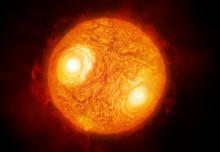Listen to today's episode of StarDate on the web the same day it airs in high-quality streaming audio without any extra ads or announcements. Choose a $8 one-month pass, or listen every day for a year for just $30.
You are here
Moon and Antares
The Sun is really big — more than a hundred times the diameter of Earth. Yet it’s a mere dot compared to a star that huddles close to the Moon tonight. That star is almost a thousand times the diameter of the Sun — one of the giants of the galaxy. If it took the Sun’s place, it would extend most of the way out to Jupiter, engulfing Earth and the other inner planets.
Antares is the leading light of Scorpius. It’s to the lower right of the Moon as they climb into view, after midnight. The brilliant planet Jupiter rises to their lower left; more about that tomorrow.
Antares consists of two stars. The lesser one is still a monster — many times the size and mass of the Sun. Yet it’s hidden by the glow of the main star, known as Antares A.
Estimates of the size and mass of Antares A vary. But it’s probably about 15 times the mass of the Sun. That great weight squeezes its core, revving up the nuclear reactions that power the star and making the core especially hot. Radiation from the hot core pushes on the surrounding gas, inflating Antares to supergiant proportions.
That size makes it especially bright — about 10,000 times brighter than the Sun at visible wavelengths. But the surface of Antares is cooler than the Sun. Cooler stars emit much of their energy in the infrared. When you add that to the visible light, Antares is at least 60,000 times the Sun's brilliance — a giant display from a giant star.
Script by Damond Benningfield



